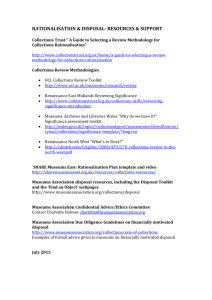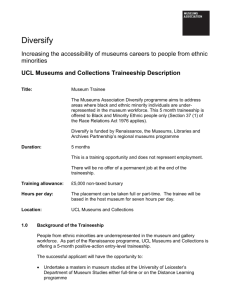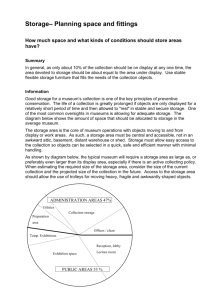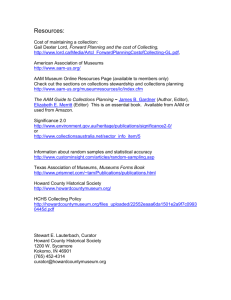Staying Essential: Articulating the Value of Object Based Learning H C
advertisement
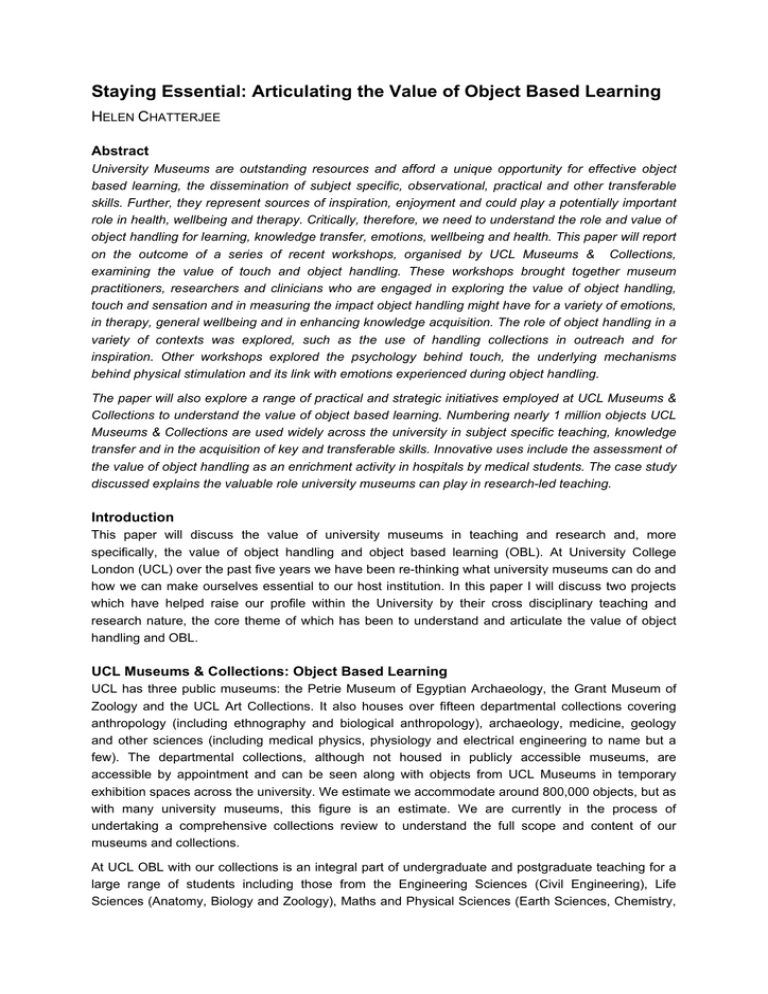
Staying Essential: Articulating the Value of Object Based Learning HELEN CHATTERJEE Abstract University Museums are outstanding resources and afford a unique opportunity for effective object based learning, the dissemination of subject specific, observational, practical and other transferable skills. Further, they represent sources of inspiration, enjoyment and could play a potentially important role in health, wellbeing and therapy. Critically, therefore, we need to understand the role and value of object handling for learning, knowledge transfer, emotions, wellbeing and health. This paper will report on the outcome of a series of recent workshops, organised by UCL Museums & Collections, examining the value of touch and object handling. These workshops brought together museum practitioners, researchers and clinicians who are engaged in exploring the value of object handling, touch and sensation and in measuring the impact object handling might have for a variety of emotions, in therapy, general wellbeing and in enhancing knowledge acquisition. The role of object handling in a variety of contexts was explored, such as the use of handling collections in outreach and for inspiration. Other workshops explored the psychology behind touch, the underlying mechanisms behind physical stimulation and its link with emotions experienced during object handling. The paper will also explore a range of practical and strategic initiatives employed at UCL Museums & Collections to understand the value of object based learning. Numbering nearly 1 million objects UCL Museums & Collections are used widely across the university in subject specific teaching, knowledge transfer and in the acquisition of key and transferable skills. Innovative uses include the assessment of the value of object handling as an enrichment activity in hospitals by medical students. The case study discussed explains the valuable role university museums can play in research-led teaching. Introduction This paper will discuss the value of university museums in teaching and research and, more specifically, the value of object handling and object based learning (OBL). At University College London (UCL) over the past five years we have been re-thinking what university museums can do and how we can make ourselves essential to our host institution. In this paper I will discuss two projects which have helped raise our profile within the University by their cross disciplinary teaching and research nature, the core theme of which has been to understand and articulate the value of object handling and OBL. UCL Museums & Collections: Object Based Learning UCL has three public museums: the Petrie Museum of Egyptian Archaeology, the Grant Museum of Zoology and the UCL Art Collections. It also houses over fifteen departmental collections covering anthropology (including ethnography and biological anthropology), archaeology, medicine, geology and other sciences (including medical physics, physiology and electrical engineering to name but a few). The departmental collections, although not housed in publicly accessible museums, are accessible by appointment and can be seen along with objects from UCL Museums in temporary exhibition spaces across the university. We estimate we accommodate around 800,000 objects, but as with many university museums, this figure is an estimate. We are currently in the process of undertaking a comprehensive collections review to understand the full scope and content of our museums and collections. At UCL OBL with our collections is an integral part of undergraduate and postgraduate teaching for a large range of students including those from the Engineering Sciences (Civil Engineering), Life Sciences (Anatomy, Biology and Zoology), Maths and Physical Sciences (Earth Sciences, Chemistry, Staying Essential · 2 Palaeobiology) and Social and Historical Sciences (Anthropology, Archaeology, History of Art, Museums, Conservation and Heritage Studies). We have around 3000 students per year using the collections across 100 courses in the university. Collections are also used in tertiary education (university and further education) by students from outside UCL and for informal and formal learning across all age groups. Objects are employed in a variety of ways to enhance and disseminate subject specific knowledge, to facilitate the acquisition of practical, observational and drawing skills and for inspiration. Objects are used both within disciplines and across, for example arts students produce installations in the Grant and Petrie Museums. In addition, each year MA Museums Studies students from UCL use the collections in teaching and research and in the development of exhibitions in UCL’s temporary exhibition spaces. At UCL Museums & Collections one of our core strategic goals is to reposition our collections to make them an essential component of university teaching and research. One of the advantages of university museums is the ability to actively research and to generate new areas of research. The projects discussed below are based around articulating the value of object handling and critically involve both teaching and research elements. Touch and the Value of Object Handling The first project was funded by the UK’s Arts and Humanities Research Council and involved the organisation of a series of workshops exploring the value and role of touch and object handling in a variety of contexts. The aims was to bring together a diverse range of experts from academic, clinical and museum environments with a view to establishing a network where information regarding the value of object handling can be shared and developed. We organised six workshops across six months in 2006-7 which looked at: - The history of touch New technologies for exploring object interpretation Touch, memory and reminiscence Therapeutic approaches to touch Knowledge transfer in object handling, particularly for disadvantages or underrepresented groups such as diaspora Contributors gave both theory based and experiential talks. The history of touch and the science behind touch, including the psychological and neurological basis of touch, was explored by both museum professionals and academics. There were many examples of case studies, such as the development and success of a 1940’s Nostalgia Room at London’s Newham University Hospital. This room was created to replicate as closely as possible a living room from 1940’s Britain. It contains furniture and objects either loaned from museums, private individuals or purchased. The room was geared towards elderly patients in the hospital as a place where they were invited to explore the contents of the room and reminisce. Reports note that this interaction evokes deep emotional responses in the patients who use the room (O’SULLIVAN 2008). We heard of one female patient with Alzheimer’s disease who had not spoken a coherent sentence for five years. On engaging with objects in the room and on hearing the piano the patient gave a word perfect rendition of a popular wartime song. Her family and doctor who had accompanied her to the room were overwhelmed and thrilled at the response this interaction elicited and the example demonstrates the power and potential value of collections’ interactions. This is just one of the many examples and case studies we heard about the value of object handling. The project culminated in a final workshop seeking to bring together the various themes and our experiences are available as an edited volume (CHATTERJEE, 2008). Staying Essential · 3 Museum Loan Boxes as an Enrichment Activity in Hospitals: a Research Project Undertaken by Medical Students at UCL The second project involved research undertaken by medical students as part of their Special Study Module (SSM) and investigated the therapeutic or enrichment potential of taking museum loan boxes to patients bedsides. SSM’s are defined by the UK’s General Medical Council as: “... that part of the course which goes beyond the limits of the core, that allows students to study in depth in areas of particular interest to them, that provides them with insights into scientific method and the discipline of research and that engenders an approach to medicine that is constantly questioning and self-critical”. SSM’s are a compulsory component in the first and second year of a medical degree and students are free to select a research project of their choosing from across the biomedical sciences. One of the key reasons UCL Museums & Collections embarked on this initiative and developed an SSM research project, was to involve museum objects in teaching and research in an innovative way to demonstrate the unique, interdisciplinary, role collections can play in university life. Importantly the project sought to provide medical students with patient communication skills, methods of assessing wellbeing and research techniques. The core research aim to be investigated by the medical students was to evaluate the potential of object handling as a novel enrichment activity in hospitals. In doing this research the initiative also provided patients at University College Hospital with a novel engagement activity and widened access to UCL Museums & Collections to a previously excluded audience. The clinical basis for this project lies in the fundamental idea that improving the quality of the hospital environment and enriching patient’s lives whist in hospital can have a positive effect for patients and staff. This was perhaps first noticed by Florence Nightingale in the 1860’s who noted that: “The effect in sickness of beautiful objects, and especially of brilliancy of colour is hardly at all appreciated [by the authorities] … [ The] variety of form and brilliance of colour in the objects presented to patients are actual means of recovery.” Some of the first clinical evidence came from Roger Ulrich in 1984 who showed that patients with a view of trees had a reduced length of stay in hospital compared to those with a view of a brick wall. Since then further clinical evidence has shown that arts in health has several positive therapeutic and medical outcomes for patients including: - Reduction of stress Reduction of depression and anxiety Reduced blood pressure Reduced pain intensity Reduced need for medication Improved mental health Reduced length of stay Further, there are positive effects for staff and benefits in the education and training of medical practitioners including: - Improved morale and job satisfaction Improvement in job retention Increased communication and awareness between patients and staff Reduced stress levels Staying Essential · 4 - Increased observational skills A discussion of the role of arts in health can be found in Dolev et al. (2001) and Staricoff (2006). Today arts programmes, including artist residencies, music therapy and dog patting, are becoming an integral part of life in many hospitals. The aim of this research was to establish if museum collections and object handling could play a beneficial role for hospital patients, staff and students. We recruited five second year SSM medical students who took loan boxes comprising objects from across UCL museums and collections (including artworks, archaeological artefacts and natural history specimens) to patients bedsides during the winter and spring terms of 2006-7. Prior to data collection students were given training in object handling, infection control, patient communication skills and data handling and analysis. With training complete the students began a series of visits to patient’s bedsides at UCL Hospital in November 2006. The students began their sessions by asking several quantitative questions whereby patients completed a mood adjective checklist and two wellbeing scales. The former presented a series of moods (e.g. sluggish, nervous, vigorous, lively) with options to grade these emotions, from ‘not at all’ to ‘extremely’. The wellbeing scales comprised linear metric scales known as ‘visual analogue scales’ with grades from 0 (e.g. worst imaginable health state and extremely dissatisfied with life) to 100 (e.g. best imaginable health state and extremely satisfied with life) (Fig. 1). Patients were required to grade their mood, their perception of their overall health status and provide an overall life satisfaction score at the start and end of each handling sessions. Fig. 1 - Generic Visual Analogue scale used to assess patients’ perception of their health status The handling session comprised the student asking the patient to choose an object and then a series of questions were posed, such as: - Why have you chosen that object? What do you think this object is? What does the object feel like? Can you think of any experience that might relate to this object? Where do you think it comes from? What material do you think it is made out of? Sessions were recorded using digital audio recorders and this information formed the basis for qualitative analyses. Outcomes The students made a combined total of 35 visits to UCH and interviewed 21 patients. Post-data collection the students transcribed the audio-recordings and used basic mind mapping methods to Staying Essential · 5 ascertain themes and trends in the qualitative information retrieved from these recordings. This technique involves the selection of key phrases and themes from interview transcripts and mapping their frequency in a given data set. Quantitative quality of life data extracted from the visual analogue scales (VAS) were analysed using simple statistical techniques (i.e. Student’s t-test) to understand frequency distribution. These tests showed that there was an overall improvement in patient’s perception of their general wellbeing and health status when the VAS from the start of the handling sessions (‘before’) was compared to those from the end of the sessions (‘after’). These results were significant at the 95% confidence level. Other quantitative analyses undertaken by the students indicated 57% of patients revealed a difference ‘before’ compared to ‘after’ the handling session with regard to general wellbeing, with 43% showing no difference ‘before’ compared to ‘after’; 38% of patients revealed a difference ‘before’ and ‘after’ the handling session in health status perception, compared to 62% who showed no difference. None of the VAS data showed a decrease in either score after the session. Overall, quantitative analyses indicated an increase in overall wellbeing and patient’s perception of their health status at the end of the session. Qualitative analyses revealed patients felt positive about the role of object handling sessions as a distraction from everyday ward life and had a positive impact on relationships amongst staff and patients. As pilot research these outcomes are very informative and we are using these methods in parallel projects across the hospital to extend and continue this research (CHATTERJEE & NOBLE 2008). A critical factor in the success of this project was engaging key people from the hospital, including clinical staff. The project was co-run by the Arts Curator at UCL Hospital and his contribution was crucial in engaging doctors, nurses and support staff to help with training and the logistics of gaining access to patients. We also had to obtain Research Ethics Committee approval prior to the start of the project. The initiative demonstrates the value for medical student training in providing first hand experience of patient contact in a context outside their clinical care. This provided the student’s with a different perspective of patient care and gave an insight into patient’s emotions whilst in hospital. Critically the project has significantly raised the profile of UCL Museums & Collections within UCL, demonstrating our value as a core resource in teaching and research. The teaching and research elements of the project exemplify that collections can be useful tools for inspiring cross disciplinary study, providing a novel research area for a new body of students using the collections. Future Directions In the future we will continue to raise the profile of UCL’s Museums & Collections by promoting the valuable role university museums can play in achieving the strategic goals of Universities, particularly with regard to teaching and research. Further initiatives are planned for wider involvement of the collections in cross disciplinary undergraduate and postgraduate teaching and the Museum Loan Box SSM will continue to be run for medical students. Finally, we are continuing our research into the role and value of object handling for: knowledge transfer and learning, skills acquisition, wellbeing, emotions and enjoyment. Literature Cited CHATTERJEE, H.J. 2008. Touch in museums: Policy and practice in object handling. Oxford: Berg. CHATTERJEE, H. J. & G. NOBLE 2008. Enrichment programmes in hospitals: Using museum loan boxes in University College London Hospital. In Touch in museums: Policy and practice in object handling, ed. H.J. CHATTERJEE (Oxford: Berg). DOLEV, J. C., L. K. FRIEDLANDER & I. BRAVERMAN 2001. Use of fine art to enhance visual diagnostic skills. Journal of the American Medical Association 286 (9): 1020–1021. Staying Essential · 6 General Medical Council 2003. Tomorrow’s doctors. London: GMC. O’SULLIVAN, J. 2008. See, touch and enjoy: Newham University Hospital’s nostalgia room. In Touch in museums: Policy and practice in object handling, ed. H. J. CHATTERJEE (Oxford: Berg). STARICOFF, R. L. 2006. Arts in health: A review of the medical literature. Arts Council, Research Report 36. UCL Museums & Collections 2006. Inspire: Highlights of UCL’s collections. London: Grant Museum of Zoology. ULRICH, R. S. 1984. View through a window may influence recovery from surgery. Science 224: 42– 421. Contact Dr. Helen Chatterjee Deputy Director, UCL Museums & Collections, Lecturer in Biology Address: University College London, Darwin Building, Gower Street, London. WC1E 6BT E-mail: h.chatterjee(at)ucl.ac.uk


